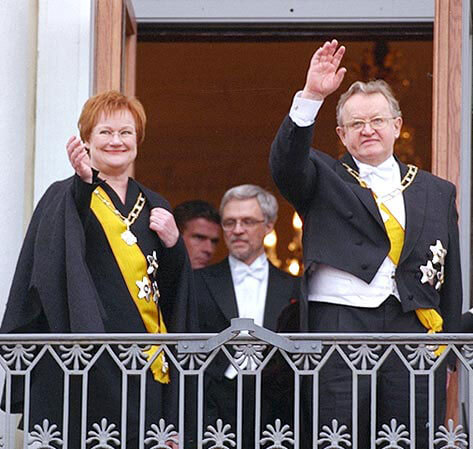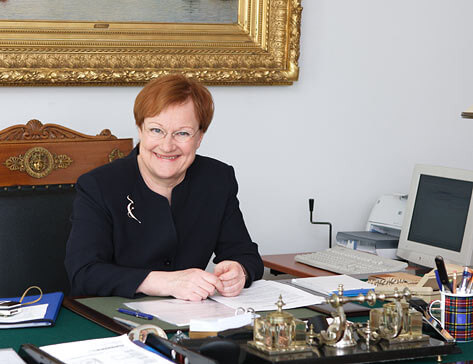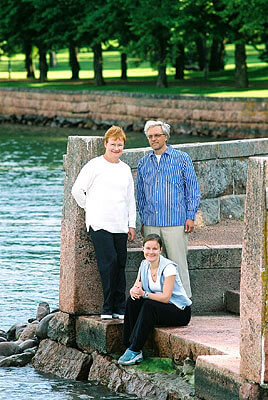Tarja Kaarina Halonen syntyi jouluaattona 1943 Helsingissä. Hänen vanhempansa, rakennustyöläinen Vieno Halonen ja Lyyli Loimola avioituivat toisen maailmansodan aikana. Vieno Halonen oli tyttären syntyessä rintamalla, ja Lyyli Halonen kävi ansiotöissä muiden työläisvaimojen tapaan. Perheen koti oli Kallion työläiskaupunginosassa. Isä jätti perheen Tarjan ollessa vain kaksivuotias. Lyyli Halonen solmi uuden avioliiton vuonna 1950 sähköasentaja Thure Forssin kanssa, josta tuli Tarjalle läheinen isähahmo ja aatteellinen esikuva. Myös vahvan äidin arvomaailma on vaikutti tyttären maailmankuvaan. Lyyli äiti arvosti hyviä ja vaatimattomia työihmisiä, rehellisyyttä sekä oikeudenmukaisuutta.
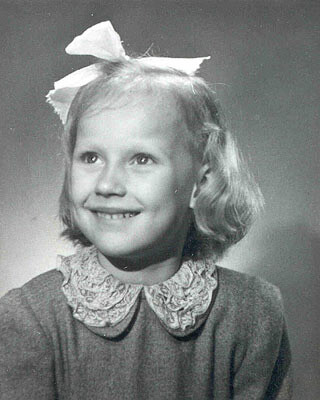
Tarja aloitti opintiensä Kallion kansakoulussa syksyllä 1950. Neljä vuotta myöhemmin hän siirtyi Kallion yhteiskouluun, mistä hän kirjoitti työläissukunsa ensimmäiseksi ylioppilaaksi vuonna 1962. Helsingin yliopiston oikeustieteelliseen tiedekuntaan Tarja kirjoittautui syksyllä 1963 opiskeltuaan sitä ennen vuoden taidehistoriaa. Hän valmistui oikeustieteen kandidaatiksi pääaineenaan rikosoikeus vuonna 1968.
Työura
Työuransa Tarja Halonen aloitti jo ennen juristiksi valmistumistaan Luotonvalvonta oy:n lakimiehenä 1967. Parin vuoden jälkeen hän siirtyi Suomen Ylioppilaskuntien Liiton (SYL) sosiaali- ja järjestösihteeriksi, jossa hän kiinnostui politiikasta ja liittyi sosiaalidemokraattiseen puolueeseen. Tarja Halonen palkattiin 1970 Suomen Ammattiliittojen Keskusjärjestön (SAK) lakimieheksi, jolloin hänestä tuli SAK:n ensimmäinen naisjuristi.
Politiikkaan
Tärkeän askeleen kohti poliitikon uraa hän otti 1974, jolloin hänestä tuli pääministeri Kalevi Sorsan eduskuntasihteeri. Halosesta tuli näin SDP:ta, istuvaa hallitusta ja ammattiyhdistysliikettä yhdistävä side. Sorsa huomasi pian, että nuori juristi oli itsenäisesti ajatteleva, mutta samalla hallitukselle ehdottoman lojaali työtoveri. Kiinnostus politiikkaan kasvoi. Vuonna 1977 Halonen aloitti lähes kaksikymmentä vuotta kestäneen kunnallispoliittisen uransa, kun hänet valittiin Helsingin kaupunginvaltuustoon.

Syksyllä 1978 Halosen oli tarkoitus osallistua valtakunnallisen maanpuolustuskurssin kertausjaksolle kurssin emäntänä. Hänen piti lentää tapaamista varten Kuopion Rissalaan, mutta lääkäri kielsi lentämisen pitkällä olleen raskauden vuoksi. Lääkärin määräys pelasti Halosen ja hänen vielä syntymättömän tyttärensä hengen, sillä lentokone syöksyi maahan paluulennollaan Helsinkiin. Kaikki koneen matkustajat kuolivat. Loppuvuodesta 1978 Tarja Halonen ja hänen avopuolisonsa, SDP:n eduskuntaryhmän silloinen sihteeri Kari Pekkonen saivat Anna-tyttären. Vuonna 1979 Halonen pyrki toistamiseen eduskuntaan SDP:n listoilta ja tuli valituksi. Äiti Lyyli auttoi vauvan hoidossa ja olipa vauva joskus mukana eduskunnassakin. Halonen ja Pekkonen erosivat 1980-luvun alkupuolella.
Eduskunnassa työmarkkinajuristi Halosen ansiot huomattiin pian, ja hän sai osakseen lukuisia luottamustehtäviä. Hän oli muun muassa sosiaalivaliokunnan puheenjohtaja 1984–1987 ja lakivaliokunnan varapuheenjohtaja 1991–1995. Poliitikkona Halonen oli tiukan asiallinen, päämäärätietoinen ja kunnianhimoinen, mutta toisaalta humaani, suvaitsevainen ja sydämellinen. Hänestä on osuvasti sanottu, että hän on mielenkiintoinen yhdistelmä aatteellista idealistia ja realistia ”saman hatun alla”.
Poliittisen uransa aikana Halonen oli aktiivisesti mukana myös järjestötoiminnassa. Se näyttää olleen hänelle pikemminkin elämäntapa kuin harrastus. Hän on ollut mukana muun muassa solidaarisuusliikkeessä sekä puolustamassa ihmisoikeuksia ja rauhaa. Vaikka Halonen ei kuulunut luterilaiseen kirkkoon, hän on ollut mukana myös kristillisessä työssä, kuten Suomen Setlementtiliitossa. Hänen suvaitsevaisuudestaan kertoo, että hän on toiminut luottamustehtävissä Seksuaalinen tasavertaisuus (SETA) ry:ssä, rasismin vastaisessa valtuuskunnassa ja Romaniasiain neuvottelukunnassa. Myös ikääntyneiden ihmisten ongelmat ovat olleet lähellä Halosen sydäntä, ja hän on ollut mukana Vanhus- ja lähimmäispalvelun liiton hallinnossa. Lisäksi hän on toiminut erinäisissä kulttuuri- ja urheilujärjestöissä. Taide, kulttuuri ja siirtolapuutarhan hoito ja liikunnalliset harrastukset toivat iloa vapaa-aikaan.
Ministeriuransa Tarja Halonen aloitti 1987, jolloin hänet nimitettiin Harri Holkerin hallituksen sosiaalihuolto-, alkoholi- ja tasa-arvoasioista vastaavaksi sosiaaliministeriksi. Hän hoiti 1989–1991 myös pohjoismaisen yhteistyöministerin tehtävää ja 1990 hänestä tuli oikeusministeri. Ministeriura jatkui 1995 Paavo Lipposen ensimmäisen hallituksen ensimmäisenä naispuolisena ulkoasiainministerinä. Päteväksi havaittu Halonen jatkoi ulkoasiainministerinä myös Lipposen toisessa hallituksessa aina presidentiksi valitsemiseensa saakka.
Presidentiksi
Vuoden 2000 presidentinvaalien lähestyessä SDP:ssä alettiin järjestää puolueen esivaalia. Istuva presidentti Martti Ahtisaari ilmoitti vähän ennen ehdokkaaksi ilmoittautumisajan päättymistä, että hän jää syrjään vaaleista kokonaan. Tarja Halonen valittiin SDP:n ehdokkaaksi ja hän kävi presidenttitaistonsa Keskustan puheenjohtajan Esko Ahon kanssa. Toisella äänestyskierroksella Halonen sai 51,6 % äänistä ja Suomi ensimmäisen naispresidenttinsä. Ainoastaan neljässä maailman maassa on ollut naispuolinen presidentti ennen Suomea. Vaalit teki jännittäviksi se, ettei Halonen edustanut niin sanottuja perinteisiä arvoja: hänellä oli tunnetusti vasemmistodemarin maine, hän eli avoliitossa Pentti Arajärven kanssa eikä kuulunut kirkkoon. Hänen arkisen rento olemuksensa, asiantuntevat kommenttinsa sekä aidoksi koettu esiintymisensä tekivät hänestä kuitenkin Ahoa suositumman.
Maaliskuun alussa 2000 virkaansa astunut presidentti Tarja Halosen ensimmäinen presidenttikausi alkoi juuri uudistetun perustuslain merkeissä Laki astui voimaan samana päivänä, kun Halonen astui virkaansa. Hän puolusti sen mukaisia valtaoikeuksiaan määrätietoisesti etenkin ulkopolitiikkaan ja puolustusvoimien komentajuuteen liittyvissä kysymyksissä. Halonen linjasi rooliaan toteamalla, että presidentin tulee olla laillinen, vahva ja yhteistyökykyinen. Halonen hoiti sotilaalliset ja valtiolliset tehtävänsä yhtä säntillisesti kuin edeltäjänsä, mutta korosti enemmän tasa-arvokysymyksiä ja oli esiintymistavaltaan mutkattomampi. Presidenttiin saattoi törmätä arkisissa merkeissä kaupassa, bussissa tai vaikka vatsatanssitunnilla. Ensimmäisen presidenttivuotensa kesällä hän meni yllättäen naimisiin pitkäaikaisen elämänkumppaninsa tohtori Pentti Arajärven kanssa. Halonen uudisti itsenäisyyspäivän juhlia, kun hän emännöi niitä ensimmäistä kertaa. Juhlavieraiden joukossa oli aiempaa enemmän nuoria vaikuttajia, kansalaisjärjestöjen edustajia ja kulttuuriväkeä.
Maaliskuussa 2002 Halonen alkoi johtaa YK:n globalisaation sosiaalista ulottuvuutta selvittävää komissiota yhdessä Tansanian presidentti Benjamin Mkapan kanssa. Huhtikuussa hän tapasi Valkoisessa talossa tuoreen Yhdysvaltain presidentti George Bushin. Vuoden 2002 tapaaminen oli viimeinen virallinen tapaaminen pitkään aikaan Yhdysvaltojen ja Suomen ylimmän johdon välillä, ja tämä herätti Suomessa myöhemmin runsaasti keskustelua Suomen ja Yhdysvaltojen suhteista. Halonen arvosteli 2000-luvulla kärkkäästi George Bushin johtamaa hallintoa Irakin sodan aloittamisesta ja myöhemmin myös hallinnon hyväksymistä kidutuksista. Halonen totesi YK:n turvallisuusneuvoston istunnossa pitävänsä Yhdysvaltain johtamaa Irakin sotaa laittomana ja kansainvälisten sopimusten vastaisena.
Vuoden 2003 vaalien jälkeen Suomi sai ensimmäisen naispääministerinsä, keskustan Anneli Jäätteenmäen ja tästä presidentti oli hyvin ilahtunut. Jäätteenmäen kausi jäi kuitenkin lyhyeksi. Jäätteenmäki oli käyttänyt vaalien aikana tietojaan Irakin sodasta SDP:n Paavo Lipposta vastaan. Salaiseksi luokitellut tiedot oli hänelle vuotanut presidentin oma neuvonantaja Martti Manninen. Jäätteenmäki jätti eronpyyntönsä presidentille kesäkuussa presidentin kesäasunnolla Kultarannassa ja hänen tilalleen pääministeriksi nousi Matti Vanhanen.
Halosen toinen virkakausi alkoi maaliskuun alussa 2006 tiukan vaalikamppailun jälkeisessä jännitteisessä tilanteessa. Vastapelurina oli ollut Kokoomuksen Sauli Niinistö. Halonen voitti niukasti vaalin toisella kierroksella saaden 51,8 % äänistä. Vaalivoittonsa jälkeen Halonen ilmoitti aikovansa olla toisella presidenttikaudellaan rohkeampi, puhuessaan hyvinvointiyhteiskunnan ongelmista. Halosen toisen kauden alkua hallitsi keskustelu perustuslain uudistuksesta ja presidentin valtaoikeuksien supistamisesta hallituksen eduksi. Halonen noudatti määrätietoisesti vallitsevaa lainsäädäntöä etenkin presidentin ulkopoliittisten valtaoikeuksien osalta eikä suostunut mukautumaan perustuslain tarkastamiskomitean esityksiin valtaoikeuksien supistamisesta. Hän perusteli presidentin valtaoikeuksien säilyttämistä sillä, että presidentti tarvitsee todellista valtaa voidakseen toimia yhteiskunnallisena arvovaikuttajana. Halonen osallistui arvokeskusteluun muun muassa ottamalla puheissaan esille vanhusten aseman heikkoudet, suomalaisen väkivallan ja uusköyhyyden. Hän korosti myös yhteisvastuuta, tasa-arvoa ja ammatillisen koulutuksen tärkeyttä. Halonen on todennut presidentin työssä olevan parasta sen, että saa olla tekemisissä ihmisten arjessa merkittävien ajankohtaisten asioiden kanssa. Presidenttikausiensa aikana Halonen teki yhteensä 270 ulkomaanvirkamatkaa.
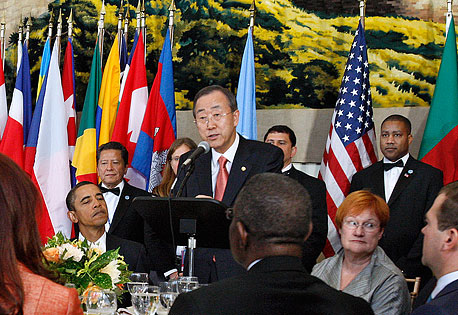
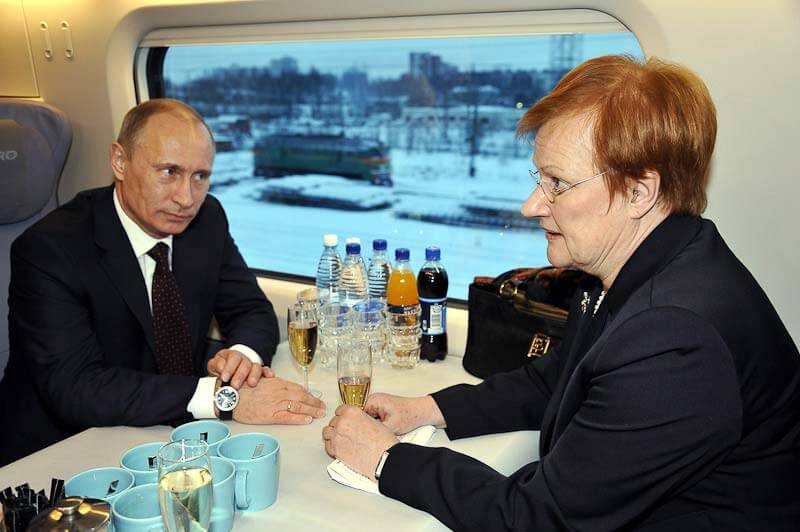
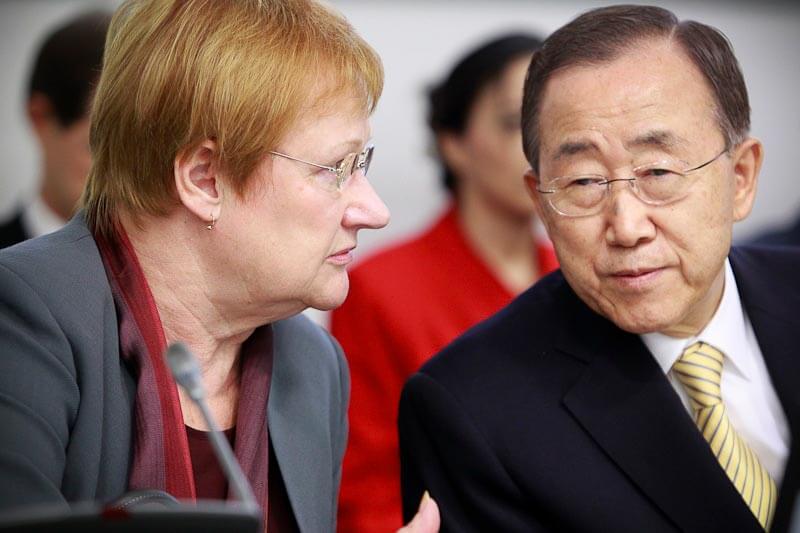

Presidentti Halonen kiinnittyi viimeisimpien virkavuosiensa aikana aikaisempaa tiiviimmin YK:ta lähellä olevaan toimintaan. Vuonna 2009 Halonen nimettiin Kansainvälisen naisjohtajaverkoston puheenjohtajaksi ja 2011 YK:n kauppa- ja kehitysjärjestö UNCTADin neuvonantajapaneelin puheenjohtajaksi. Tarja Halosen kausi Suomen tasavallan presidenttinä päättyi 1.3.2012, ja kokoomuksen Sauli Niinistö aloitti virkakautensa. Viimeisimmässä lehdistötilaisuudessaan Halonen sanoi aikovansa jatkaa osallistumistaan yhteiskunnalliseen keskusteluun. ”Olen sellainen, että elän aina tässä hetkessä.”
Presidentin viimeistä virkavuotta kuvaavan Rouva Presidentti -elokuvan ensi-illassa (28.3.2012) Halonen totesi, että se antaa presidentin työstä hyvin kiireisen ja totuudenmukaisen kuvan. Presidenttikautensa jälkeen Halonen jatkaa työtään lukuisissa kotimaisissa ja kansainvälisissä järjestöissä.
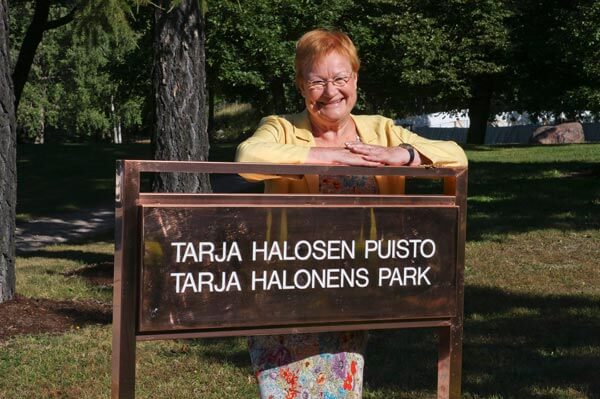
Tarja Halosen mukaan on nimetty pensasruusulajike vuonna 2011, jonka hän itse istutti Kallion Torkkelinpuistoon ja puistikko Helsingin kaupunginteatterin vieressä vuonna 2013, jolloin Tarja Halonen täytti 70 vuotta.
